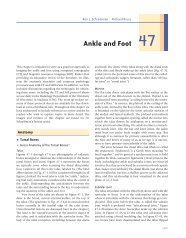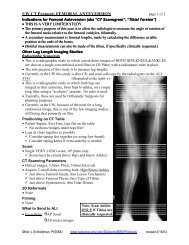CT Arthrography (CTR)
CT Arthrography (CTR)
CT Arthrography (CTR)
You also want an ePaper? Increase the reach of your titles
YUMPU automatically turns print PDFs into web optimized ePapers that Google loves.
<strong>CT</strong>R studies use double contrast. Also, machine availability may direct procedure choice<br />
at some institutions.<br />
There are some basic concepts that are important to the discussion of indications. First,<br />
iodinated contrast used in <strong>CT</strong>R is FDA approved for joint injection, whereas gadolinium<br />
is not. Straight saline is an alternative to dilute gadolinium for MRR, but would not be<br />
expected to allow quite the same signal to noise because it requires T2-weighted imaging.<br />
Second, much of the power of <strong>CT</strong>R lies in the sub-millimeter resolution capability of<br />
current generation multi-detector scanners. Third, another powerful feature of <strong>CT</strong>R is the<br />
incredible contrast between calcium (cortex), soft tissues (such as hyaline cartilage), and<br />
the iodinated contrast material. With MRR, one may generate sequences that provide<br />
excellent contrast between gadolinium/saline and cartilage, but the delineation between<br />
cortex and cartilage/soft tissues often is quite indistinct. So <strong>CT</strong>R may often be superior<br />
in defining morphologic cartilage defects. This is one of the areas in which future<br />
advances in MR technology may change the playing field. Fourth, a powerful feature of<br />
MR is its ability to define differences between various types of soft tissue; that sort of<br />
soft tissue contrast is very limited with <strong>CT</strong> techniques. This may come into play if one is<br />
evaluating for alterations of cartilage without morphologic defects, for instance. Fifth,<br />
<strong>CT</strong>R will usually be a much quicker procedure. One or at most two volumes of data are<br />
sufficient to provide adequate multiplanar reformatted images tailored to the clinical<br />
question, and the individual scans are much quicker than MR sequences, reducing motion<br />
artifacts. Sixth, <strong>CT</strong>R and MRR bring on certain risks, such as ionizing radiation for the<br />
former and high strong magnetic fields for the latter. Seventh, <strong>CT</strong>R is better at defining<br />
calcified structures, such as the Bennett lesion in the posterior glenoid labrum of the<br />
shoulder and chondrocalcinosis.<br />
With all of these considerations, at the University of Wisconsin, <strong>CT</strong> arthrography remains<br />
primarily a poor man’s MRR. Our wait times for MR scanners are not sufficiently long<br />
for us to search for an alternative to MRR. So, our primary indications for <strong>CT</strong>R include:<br />
Patient scheduled for MRR, injected, but then cannot tolerate the magnet due to<br />
claustrophobia<br />
Patient requiring multiplanar cross sectional imaging of a joint with arthrogram<br />
effect, but with contraindications to MR scanning<br />
Evaluation of the postoperative joint with significant intra-articular metal (for<br />
instance, suture anchors in the shoulder)<br />
Secondary indications for <strong>CT</strong>R include:<br />
Evaluation for hyaline cartilage defects<br />
Evaluation for calcified structures within the joint in addition to internal<br />
derangement<br />
Within each specific joint discussed below, I will reference some of the recent published<br />
literature. These studies do not represent the sum of all scientific data on the subject but<br />
are meant to be a representation of the available information.

















